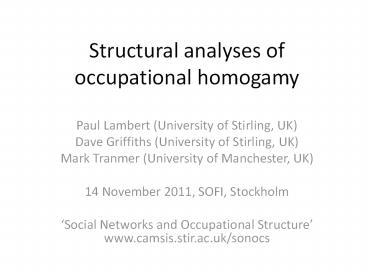Structural analyses of occupational homogamy - PowerPoint PPT Presentation
Title:
Structural analyses of occupational homogamy
Description:
... 469 US OUGs & micro-classes Green: prof.; Blue: routine non-mnl; Red ... * We can compare the way the actual model compares to the theoretical model, ... – PowerPoint PPT presentation
Number of Views:86
Avg rating:3.0/5.0
Title: Structural analyses of occupational homogamy
1
Structural analyses of occupational homogamy
- Paul Lambert (University of Stirling, UK)
- Dave Griffiths (University of Stirling, UK)
- Mark Tranmer (University of Manchester, UK)
- 14 November 2011, SOFI, Stockholm
- Social Networks and Occupational Structure
www.camsis.stir.ac.uk/sonocs
2
Three ways of analysing social connections
between occupations
- Social Network Analysis
- Social Interaction Distance analysis
- Random Effects (Multilevel) Modelling
3
1) Social Network Analysis
Network analysis to look for influential channels
of social connections between occs.
(camsis.stir.ac.uk/sonocs)
4
Hypothetical network 469 US OUGs micro-classes
Medical and dental technicians
Medical professionals
(Four different isolated components with internal
links within microclass but no external links)
Pseudo-diagonal or situs
Green prof. Blue routine non-mnl Red manual
Yellow primary Green military
Dental hygienists
(further isolated components)
5
lt-Hypothetical
Actual composition of occupational networks in
USA in 2000 links reflect stratification as much
as they do microclasses and psds
6
Red to violet for low to high CAMSIS (grouped
into 7). Structures similar to CAMSIS scales.
Using Kamada-Kawai algorithm and no manual
adjustment (expect removing some occs with no
ties/relations)
Romania, 2002
Philippines, 2000
Venezuela, 2001
7
2) Social Interaction Distance Analysis
(www.camsis.stir.ac.uk correspondence
analysis RC-II association models)
A large cross-tabulation of pairs of occupations
is modelled dimension scores help predict
frequency of occurrences in cells scaled
dimension scores are then presented as CAMSIS
scale scores.
8
- Using CAMSIS approaches, www.camsis.stir.ac.uk
- First dimension of SID scales is usually social
stratification - Wed interpret it as the contour of social
reproduction - Gradational, but lumpy for operational reasons
(occ.s) - Specificity (many scales!)
- Dimensions
- 1 main one
- numerous subsidiary patterns
- Boundaries
- None(?)
9
- Dimensions1 Boundaries none or maybe 1 in Ro?
10
(No Transcript)
11
3) Multilevel modelling
- In general, can analyse Individual level data (i)
with clustering in higher level units (j)
(occupations person groups)
12
MLMs on social network data?
- We could analyse some other process/outcome
- Own job f(x), i(spouses job)
13
Or analyse the counts of occurrences of links
themselves?
Y of links Hocc at level 2, wocc at level 1.
(Philippines)
(ICCs around 1 10)
14
- BHPS own, family friends jobs
(xtmixed, j370 occs, yspouse link)
15
Appendices
16
French occupational codes
17
(No Transcript)
18
ICC examples analysing occurrences..
Level 2 ICC, by outcome Level 2 ICC, by outcome Level 2 ICC, by outcome Level 2 ICC, by outcome
Model (hocc at level 2, wocc at level 1) freq (freq gt0) Lnfreq (freq gt 0) freq2 (with zero) Level 1 camsis score (freq gt 0)
1a (Normal null regression) 0.0086 0.1290 0.0136 0.4185
1b (1a gwage) 0.0086 0.1295 0.0136 0.4231
1f (1a diag1) 0.0446 0.1487 0.0728 0.2370
19
Linear outcomes regression
20
Logit model































